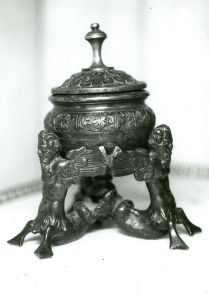Finding the Beautiful Before Us: When Craft Becomes Art
by Andrew Swensen

Inkwell supported by three tritons; Italian, likely 19th centure (Photo: Metropolitan Museum of Art)
I teach an aesthetics course, and recently I put up the image of a silver inkwell and asked the question, “What is this doing in an art museum?” There are two lessons that come early in the course, both intended to cultivate inductive logic in order to help define art. First, we need to distinguish art from objects of nature that might have an aesthetic impact, such as a sunset or the sound of a flowing stream. Art requires a person to make it, and so natural phenomena, however much they produce an aesthetic experience, are not art. The second lesson is that people make many things, but not all are art.
So we must distinguish which manmade things are art and which are not, not always an easy task. Utility provides one clue in our inductive path. “All art is quite useless,” wrote Oscar Wilde famously. His flair for the provocative leads to frequent misunderstanding of a thoroughly useful statement that directs attention to how art differs from objects of utility. Some have interpreted the statement to mean that art is frivolous, with no point or purpose. His point is that art is an end in itself and not the creation of something useful in accomplishing a task or fulfilling a practical need. If I shape some material into a vessel to hold a liquid, my goal is to contain the liquid, and my primary evaluation of the vessel depends on its ability to accomplish that task – that is, its utility.
Yet our human activity in the world of “making” does not necessarily divide clearly and simply into the useful and the useless. Some art works have no natural utility. A poem can not double as a drinking vessel, nor can a sonata work as a paperweight. Nonetheless, we humans have a habit of making things that are both beautiful and useful, ornamenting the universe of everyday objects like cups, bowls, blankets…and inkwells.

Inkwell in bronze, enamel and wood, by Caldwell & Co. (Photo: Walters Art Museum)
One wonders then where art begins and utility ends, and whether a functional object can ever be art. The questions are not academic, nor are they idle. They concern the ever frustrating matter of artistic intent and artistic reception, the latter being ever more important in the 20th and 21st centuries. If I create an object with functional purpose and then decorate it, why is it not art? The easy answer is that it is not art because its primary function is still not an aesthetic one. We consider an inkwell with engraving and filigree to be an inkwell first, and not a sculpture in silver. Therefore we put it on our desk next to a quill rather than hanging it on a wall or placing it on a plinth.
Yet no cleanly drawn boundary line divides the outer limits of the useful and the starting point of the artistic. Were that the case, then if something is 51% aesthetic and 49% useful, then we could speak of it as a work of art that happens to hold your ink. Conversely, if that thing is 51% useful and 49% aesthetic, then you have a good looking inkwell. Fallacious thinking for it is doing both, albeit one function may supersede the other in intention or reception, or both.
While original intention is static after a work is complete, reception can evolve, often in compelling ways. With our inkwell, its creator likely considered him or herself to be a “craftsperson.” However, an interesting thing happens as the function of time shapes reception. Society evolves to a place where we no longer need inkwells, but we do not want to lose this beautiful thing. Historical progress diminishes its utility but not its aesthetic value, and so what remains is a work of art.
This little case study can help us to awaken our senses to what are sometimes called the “decorative arts” and also to recognize that some crafts should perhaps not be treated as second-class citizens to the arts, but as true arts unto themselves. Other works of art have moved me more profoundly than this inkwell – Wilde’s Ballad of Reading Gaol, for example – and so the inkwell might be in a humbler place on one level. Nonetheless, I appreciate its artistry and find a home for it in the aesthetic place in my psyche. Sorry, Oscar.
This alteration of reception can lead to profound moments when we regard the useful world through aesthetic eyes. So let’s proceed from the inkwell into a second universe of function, to a place known as fiber arts and folk arts. To Alabama, Texas and finally New York City.

Mary Lee Bendolf, of Gee’s Bend, and her quilt “blocks and stripes” (Photo: Smithsonian Magazine)
In 2002, the Museum of Fine Arts, Houston (MFAH) presented an exhibition of quilts from Gee’s Bend, Alabama, and the exhibition has something to show us about discovering profound art. The artistic power of the quilts overcame any intentions of utility by changing the nature of reception, such that by the time the exhibition traveled to New York, Michael Kimmelman of the New York Times called them “some of the most miraculous works of modern art America has produced.” The real heroes of the story are of course the artists, the quiltmakers of Gee’s Bend. Others have written their story, including an excellent article from The Smithsonian, and I do not want to recapitulate what has already been said. But I do want to call attention to two other lessons in this tale, object lessons brought to us by the MFAH and Michael Kimmelman. First, the word “craft” is often used dismissively in order to dispense with something that the would-be cognoscenti deem as beneath “art” – often while praising absurdly recondite things and scorning those who don’t “get it.” The MFAH and Kimmelman show the courage to recognize something as art, and not to dismiss it as “craft” nor to diminish something as belonging to a “lesser” medium. We should all be so brave. The second object lesson lies in opening the door to perception and reception of the everyday through aesthetic eyes. There are objects in our everyday world that may have tremendous aesthetic intent and significance, and our eyes of reception should be humble enough to open to those possibilities.
Read more:
An NPR overview of the Gee’s Bend exhibit, with links to further resources.
A letter by Oscar Wilde, explaining his statement “All art is quite useless.”
Articles of Related Interest from The Muse Dialogue:
“The Allure of Liquid Fire: A Look at the Art and Craft of Glassblowing” by Kelly Englert
“Artists, Craftsmen…and the Craft of Art” by Erin Yanacek
“A Question of Arts Survival?” by Andrew Swensen









